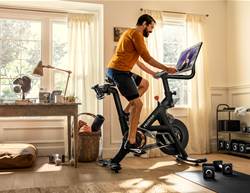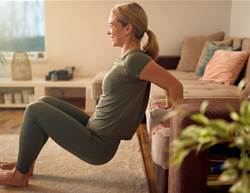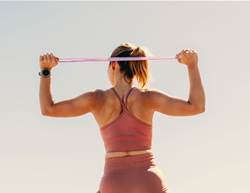Remember the “internal shower” of 2023? Or those weird vibrating ab belts from the 90s? There are always strange health and fitness trends out there and it pays to take them with a pinch of salt.
Lifespan Fitness recently analysed the top fitness trends for 2023. Their findings were based on global search and social media statistics.
Their research found the top five fitness trends that are doing the rounds right now. Trying a new type of exercise can be great to mix up your fitness routine or motivate you but physiotherapist Tim Dettmann from Kieser has some words of caution.
“Would you like to know my biggest concerns with fads? At best they last short term and offer short term benefit, at worst, they cause injury,” he says.
“Some of these fitness trends are either so niche or so incredibly challenging that people are likely to either get bored, or injured; both of which then lead to people giving up exercise. [This means] we’re back to where we started: 80% of Australians suffering back pain at some point in their lives and only 45% of Aussies meeting basic physical activity guidelines.”
So, should you try or skip these trends? We outline the top fitness trends and ask fitness pros if they are worth a try.

1. Reformer Pilates
Reformer Pilates is the ultimate fitness trend for 2023 as it's getting approximately 224,600 monthly global internet searches and has a record number of 31.4 million TikTok views (and growing!). Reformers are a platform with springs and straps attached to add resistance. Reformer Pilates is a body conditioning exercise that uses reformer machines to improve body flexibility, strength and stamina. It’s low impact and can boost strength, balance, and mobility. It has been practised since the 1920s so we think it has potential to continue as a lasting trend.
The verdict?
People often think of reformer Pilates as a core-based exercise, but Tahnee Donkin believes it can be so much more. She’s a personal trainer and National Fitness Manager at Genesis Health + Fitness.
“With a great instructor, reformer Pilates can be done as a whole body workout or tailored to target specific areas of the body. Beyond the physical benefits, reformer Pilates can help with injury prevention and offers opportunities to focus on mindfulness and breathwork.”
However, reformer Pilates requires a lot of concentration and practice to get things right. You’ll need an instructor, at least at first. And unless you can afford an expensive reformer machine, you’ll need to go to a Pilates studio. It also shouldn’t make up your whole fitness routine, says Donkin.
“Reformer Pilates ideally needs to be done with other forms of training, particular cardiovascular training as it’s unlikely you’ll get your heart rate high enough for long enough to help your cardio,” she says.

2. The 75 Hard Challenge
The 75 Hard Challenge has more than 389,700 monthly searches globally plus 25.2 million views on TikTok.
This hardcore challenge consists of following five self-improvement activities daily for over 75 days, from a set nutrition plan that suits your fitness goal but no cheat meals and cutting alcohol from your diet, to completing two 45-minutes workouts a day.
The verdict?
For Dettmann, the trend is a hard pass.
“If you are the average Australian and you go from little or no exercise to two 45 minute sessions per day, the likelihood of you getting injured is high, really high.
“I will always start someone very light on weights, but make it harder each session. Or start them on a small number of exercises and increase. The weight you lift or the intensity you run on day is not as important as what you are able to do at week six, month six and year six!”
Donkin says if you’re really dedicated, this challenge could achieve fast results. Plus, she likes that there’s a requirement for one of the daily workouts to be outdoors. But ultimately, she’s concerned about this trend.
It’s not suitable for fitness beginners, would be hard to stick to, and is “unrealistic to sustain long term”.
Plus, “this “all or nothing” approach may pose challenges for individuals who have struggled with yo-yo dieting or unhealthy exercise habits in the past.”

3. Under-desk treadmill
Under-desk treadmills and walking pads have more than 260,200 global monthly searches and more than 19.5 million views on TikTok.
While at first they seem like a gimmick, under-desk treadmills are meant to help us stay fit despite long work days at home or in the office.
But is having a treadmill under your desk practical and helpful in changing our sedentary lifestyles? Do we need to be masters of multitasking to not have an embarrassing and potentially dangerous accident?
The verdict?
We all know that sitting too much, or being sedentary, has a range of health risks, and can even shorten your lifespan.
“When used regularly, an under-desk treadmill paired with a standing desk can be a fantastic solution… as long as they are put to use and don’t become another piece of office furniture,” says Donkin.
She points to all of the fit balls and standing desks that were bought in the past that were rarely used, or not used properly.
This fitness trend gets the green light from Dettmann.
“I really like the desk treadmill. It could help people reach 7,500 steps per day to lower their mortality risk.”
“Keep in mind it can be challenging to multi-task with an under-desk treadmill, and a potential injury risk if you’re too focused on your work rather than where you’re placing your feet.”
If you’re accident or injury prone, try walking meetings instead.

4. The 12-3-30 treadmill workout
The 12-3-30 Treadmill Workout is about setting a treadmill to a 12% incline and walking at 3 miles per hour (about 5km/h) for 30 minutes. It has 80,600 monthly searches globally and 23.3 million views on TikTok.
But this treadmill workout formula isn’t necessarily a magic formula.
The verdict?
Donkin says this workout has probably gained popularity because of its simplicity “but it’s not the most effective workout to achieve fat loss or cardiovascular health results.”
“To find the most effective workout for you, first it’s important to identify your health and fitness goals. If fat loss is your goal, there are many workouts that can achieve the same or better results, with more variety, such as HIIT or boxing. If you like the idea of walking on an incline but want to avoid boredom, try hiking outdoors instead.”
Dettmann also thinks this trend has some legs.
“I also really like the 12-3-30 trend. However, it would come with the caveat that this shouldn’t be on this level on day one, rather it’s something you work up to.”

5. Weighted hula hooping
Using a weighted hula hoop sounds fun, if challenging. We’re not the only people who think so – it has 50,200 monthly searches and 9.1 million views on TikTok. There are a range of different styles – hugging close around the waist with a dangling weight to a large but heavy hoop more like the one you used as a kid.
Fans of the fitness trend claims it helps you lose weight, reduce belly fat and strengthen your core.
The verdict?
Donkin says while we enjoyed hula hooping as a kid, it’s a lot more challenging as a form of exercise and with a weighted hoop.
“This requires core control and coordination, and is not for everyone.” It can help strengthen your core and any exercise can help with weight loss. But is it the most effective way to achieve these goals?
“No, it’s likely a fad,” she says.
Dettmann agrees. “In Australia’s ageing population, where 80% of us suffer back pain at some point in their life, I’m not convinced that this is going to shift the dial in a positive direction. In fact, my concern is anyone doing too much of it might end up with more pain.”
The bottom line
While it’s tempting to believe the hype around the latest fitness trends, it’s important to be realistic about the results you can expect.
“Any form of movement is better than no movement at all,” says Donkin. “Ultimately, the key is finding an exercise routine you resonate with; something that you enjoy and can see yourself sticking with.
"If you like to be social and workout in a supportive environment, try a group fitness or group training class. If you prefer one-on-one attention and a personalised workout, consider personal training. If you loved soccer or dancing as a child, try getting back to what you love.
“Fitness doesn’t have to be boring, or gruelling or something that feels like a chore. You know you’re onto a winner when you start getting excited for your next workout!”
Dettmann has his own personal favourite fitness trend.
“The exercise I recommend the most is strength training. It has bucked every ‘trend’ in the fitness industry because it’s probably one of the safest and healthiest forms of exercise out there.
“Strength training is good for back pain, arthritis, type 2 diabetes, weight loss, decreasing blood pressure, lowering anxiety, improving cognition and preventing many chronic diseases.”
Your goal should be a realistic form of exercise that you can sustain.
“We recommend people do two 30 minute strength sessions per week because the evidence says that more time does not mean more results for your health. It’s called the ‘minimum effective dose’. The same applies to steps; 7,500 steps per day lowers your mortality risk. More steps than 7,500 doesn’t mean lower risk. So, if you are doing the minimum, then by all means do more, but the fact is that most Aussies aren’t, so let’s start with the basics.”
If you don’t know where to start with exercise, speak to a physiotherapist or doctor.









